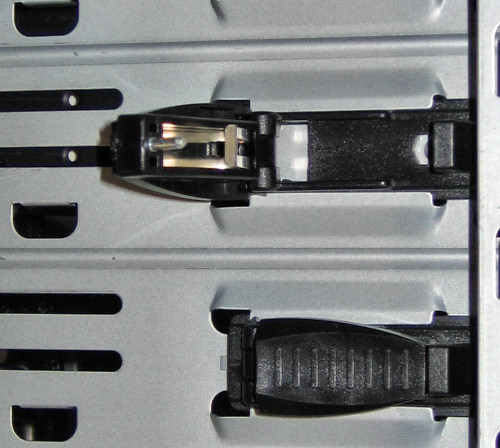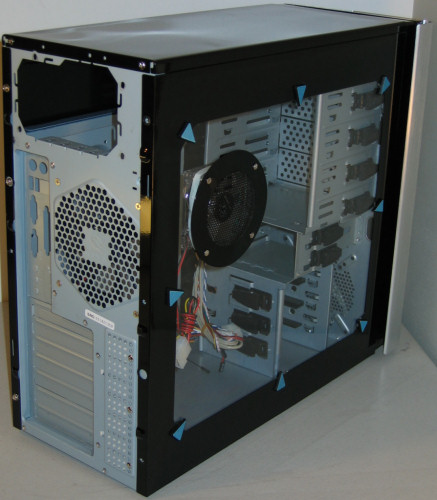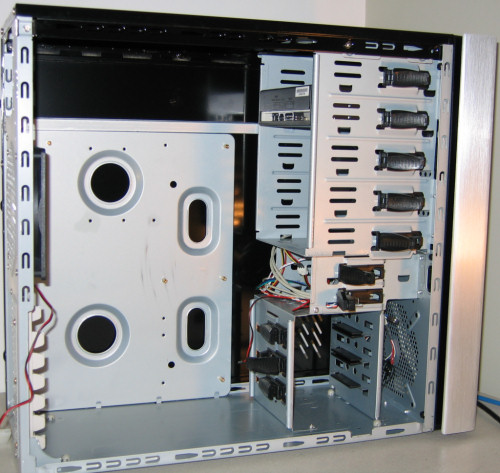Price-Point Comparing Three-Way Case Shootout
by Joshua Buss on January 13, 2006 12:05 AM EST- Posted in
- Cases/Cooling/PSUs
Raidmax X1 (cont’d)
Turning the case more, we can see the relationship of the three main elements of the active cooling in the X1: the rear 120mm, the side-mounted 80mm, and the potential power supply fan(s).
Like the P150, the X1 too has additional passive vents near the expansion slots. It’s also easier to tell now that at least in terms of 3½” drive bays, the X1 and P150 also basically tied, as they can both house 1 external and 4 internal drives. The X1’s drive bays are all tool-less, and we’ll explain the usage of the black units visible in the previous two pictures shortly. Before opening up the case though, let’s turn the case around and have a look at the bottom as well.
While certainly not as nicely-finished as the underside of the P150, the X1 still does have feet, but they’re not going to do anything for the absorption of vibrations. More intake ventilation can be found here under the front bezel, and there is a space for an additional 80mm to be mounted in order to actively bring in cool air right onto the hard drives visible here on the right side panel.
Taking off the left side and peering into the chassis reveals a spacious interior delightfully void of any additional crossbars that could make installation difficult. Granted, bars like this are actually preferred by people more concerned with case stability and longevity, but in testing and handling, we still didn't get the impression that the X1 felt wobbly or weak by any means. One very minor strike against the X1, though, is that it doesn't support quite as many form factors as the P150, as one can tell by looking at the available holes for motherboard stand-offs, but the standard ATX sizes won't be any problem.
Notice again how every bay incorporates the usage of tool-less locks. While it might be pretty obvious from the picture, it is still worthy of mention that the locks are all the same and are also equally simple to use. They simply push in and slide to both lock and unlock. In the following close-up, the pin that actually holds the drive into place is pretty visible, and in testing, these did a good job of holding the drives very securely.
Turning the case more, we can see the relationship of the three main elements of the active cooling in the X1: the rear 120mm, the side-mounted 80mm, and the potential power supply fan(s).
Like the P150, the X1 too has additional passive vents near the expansion slots. It’s also easier to tell now that at least in terms of 3½” drive bays, the X1 and P150 also basically tied, as they can both house 1 external and 4 internal drives. The X1’s drive bays are all tool-less, and we’ll explain the usage of the black units visible in the previous two pictures shortly. Before opening up the case though, let’s turn the case around and have a look at the bottom as well.
While certainly not as nicely-finished as the underside of the P150, the X1 still does have feet, but they’re not going to do anything for the absorption of vibrations. More intake ventilation can be found here under the front bezel, and there is a space for an additional 80mm to be mounted in order to actively bring in cool air right onto the hard drives visible here on the right side panel.
Taking off the left side and peering into the chassis reveals a spacious interior delightfully void of any additional crossbars that could make installation difficult. Granted, bars like this are actually preferred by people more concerned with case stability and longevity, but in testing and handling, we still didn't get the impression that the X1 felt wobbly or weak by any means. One very minor strike against the X1, though, is that it doesn't support quite as many form factors as the P150, as one can tell by looking at the available holes for motherboard stand-offs, but the standard ATX sizes won't be any problem.
Notice again how every bay incorporates the usage of tool-less locks. While it might be pretty obvious from the picture, it is still worthy of mention that the locks are all the same and are also equally simple to use. They simply push in and slide to both lock and unlock. In the following close-up, the pin that actually holds the drive into place is pretty visible, and in testing, these did a good job of holding the drives very securely.















69 Comments
View All Comments
Tamale - Friday, January 13, 2006 - link
You know, several of those descriptions never did sit well with me.. and perhaps I am a little too biased towards the geekier look... I'll try to tone down my enthusiasm for the X1 a bit.As for the hard mounting vs. soft mounting, our maxtor IDE drive is very very quiet, and seeking noises couldn't be heard in the P150 at all even using the "hard" (silicone grommets) mount.
Seeking sounds were only barely audible in the E68 and X1.
strikermlc - Friday, January 13, 2006 - link
I'm sorry, but the statement about the p150 falling short because it doesn't even have a "classy window" on the side is incredibly funny to me. Personally the p150 is the only one out of the three cases that would aesthetically have a chance of making it into an open living space in my home. I'm just as big of a gamer and hardware geek as anyone and I've been a daily reader of anandtech for years - but that comment in my opinion clearly reinforces that while anandtech should be held in very high regard for their knowledge of hardware - their aesthetic evaluations are clearly lacking.While the front of the raidmax case is not unforgivable - the side panel is. The window is downright tacky and the decorative arrows around the window are laughable - as if the window that will soon be displaying countless oversized glowing fans and other lights is incapable of attracting enough attention on it's own?
I realize everyone is entitled to their own opinion. And while I'm sure there are plenty of twelve year old anandtech readers drooling over this case, the window on this case is in no means and under no circumstances "classy" and it never will be. There have got to be plenty of adult readers at anandtech that will agree with me on this point.
True class is understated - and that's what I want my case to exhibit. Well designed functionality, quiet, crisp clean lines and quality materials - brushed metal and glossy paint are certainly fine, it doesn't have to be boring by any means. It just shouldn't fill the room with a whirling, glowing, fire-eating circus show.
Ah well, I've made my point. $0.02 from a graphic designer that loves his pc's and computer hardware just as much as the next anandtech reader, and unlike most graphic designers, regard's mac's as simply an overpriced novelty item.
Thanks and good night.
aaron
yacoub - Friday, January 13, 2006 - link
Well stated, aaron. The P150 is the most mature looking of the three cases - the most gimmick-free. Everything about it is functional and meant to meet its design goals of the best quiet-computing mid-tower on the market. It succeeds.Erssa - Friday, January 13, 2006 - link
I cannot believe that the amateur reviewer hardmounted the HDD instead of using the soft mount method, that would have subjectively really made a difference in sound levels.Very superficial review overall. I wonder what the reviewer would have said about the cases had he used a silent cpu cooler (even zalman 7700cu fan mated would have been good) and passive GPU. I believe it would have really turned out the table for antecs advantage. Sound measurements from the sides would have been a nice addition aswell. Since antec was the only case that had no ways for sound to escape from the side. Measuring noise from 6" doens't make too much sense either since nobody has his head 6" from the front of his computer. Something like 1m would have been nice, but that would have probably ment that combined with more silent combonents the sound measuring device would have proved itself inadequate.
Xenoterranos - Friday, January 13, 2006 - link
That wouldn't have really been a case test then would it? It would have been a silent-cpu-cooler-and-passive-gpu-cooler-in-cases-x-y-and-z test.While I can't disagree on the technical merrits of the Raidmax case, those little blue triangles really turn me off. Maybe I'm just not aesthetically inclined.
Trippytiger - Friday, January 13, 2006 - link
The Antec may be the most expensive of the group, but it seems to me that it also comes with the most trustworthy power supply of the three as well. I know I'd want to replace the power supply in that Raidmax case if I were going to use it.Tamale - Friday, January 13, 2006 - link
You can get it without one entirely if you want for only $50. Also, heed my note about the Raidmax supply - it's been running strong (and still is by the way) in another decently-equipped PC here in my lab.mindless1 - Friday, January 13, 2006 - link
It's been running, but what is "strong"? That it runs? The question with such PSU is not does it run but how long it does and what happens when it begins failing. If it does not last the life of the system, another PSU must be bought and all savings are negated.Tamale - Saturday, January 14, 2006 - link
By strong I simply mean steady voltages, even under load. And of course, length of life is an issue, but I've only had the power supplies for a few weeks, so I comment on that much, other than the fact that both Antec supplies I received have problems with the 3.3v rail.leofischer - Friday, January 13, 2006 - link
I doubt the drives were suspended, because he says'Also note the rubber bands stretched across the sides of this cavity. While we're not 100% sure, we are fairly certain that this is an effort to help minimize vibrations from the hard drives that may cause additional noise within the case.'
duh..
Doesn't seem like he realised what the bands were for. I assume there is some kind of explanation accompanying the case or mention of the suspension method in literature, but I wouldn't know.